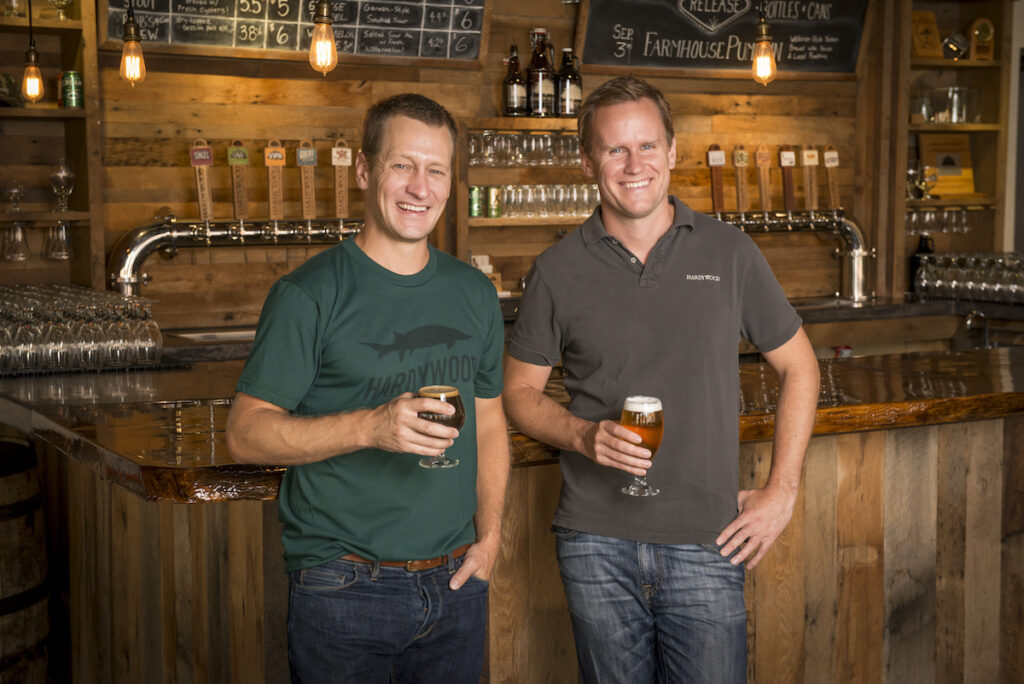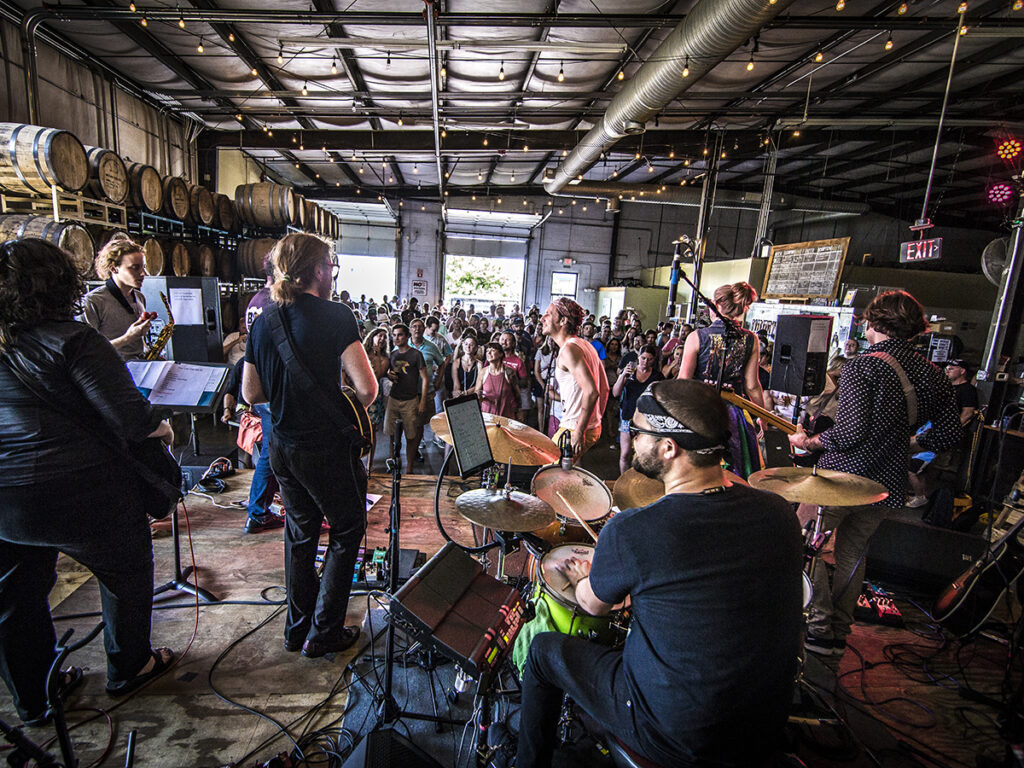Hardywood changed Richmond, Virginia. The brewery continues to be a welcome presence in the capital city, and also the state as a whole. Its identity is closely tied to Virginia, too. It’s a symbiotic relationship that perhaps all small breweries hope for. While many express terroir, few can project it nationally or even internationally like Hardywood is doing now, in part by exporting to Japan and other countries. It’s a relationship that almost didn’t happen, though. The founders, Eric McKay and Patrick Murtaugh, had their hopes pinned on another city in the American southeast. Richmond’s attraction and potential won them over.
As McKay tells the story, he was working for a large alcohol distributorship in New York in 2008 when a potential position opened in Richmond. Meanwhile, he and Murtaugh, childhood friends and fellow homebrewers, had been developing a business plan for opening their own brewery one day, and were actively considering a candidate city south of Richmond. McKay didn’t get the new position in Richmond, but asked to relocate there anyway. It was attractive privately because he and his wife both had extended family in the region and they were raising a young child. Richmond’s charm was immediately convincing.
“I quickly realized that Richmond was a better place to open a brewery. There was only one brewery in the city at the time–Legends, the godfather of craft brewing here. But in terms of independent restaurants per capita, Richmond ranked among the highest in the country. Then you have the white water rapids of the James River running through downtown and all the single-track bike trails. The river offers everything from stand-up paddle boarding to kayaking and rafting. Richmond has an environment with a sense of adventure. And if you look at Portland, Oregon, which got a head start with craft beer, it has a similar cultural make-up. When you see a city with lots of independent coffee shops and restaurants, and more of a hipster scene, you see a population that is open to trying new things.”
Murtaugh says that it wasn’t hard for McKay to persuade him to shift focus. He visited his buddy in Richmond to check out the scene, which at the time revolved around Legends, Mekong and Capital Ale House (a bar with dozens of taps). Reflecting on Mekong, they note that it had “very good food, an amazing sense of hospitality, and a great beer list”. They also felt welcomed in the city, in contrast to New York, where they said a degree of snobbery had started to set into the craft beer scene. They could see that people were thirsty for innovative beer styles that the other breweries in the state weren’t adequately serving.
McKay recalls, “An Bui and Mekong were definitely influential in our decision to move here, as were all the restaurants. We looked for warehouse property, found a spot we thought would work, signed our lease and made a down-payment on equipment–the rest is history.”

Live bluegrass, craft beer and food trucks at Hardywood Park Craft Brewery.
Virginia Tourism Corporation, www.Virginia.org
It was history already in the making, though. Murtaugh had professional brewing training, for starters. He also had a past of interesting pedigree.
“After McKay and I started homebrewing, I came across my great-great grandfather’s obituary in my parents’ attic. He had come to America from Germany in 1890 and was a brewer for Springfield Brewery (in Massachusetts; long-since defunct). Then in 2010 I decided to take my homebrewing to the next level. I enrolled in the Master Brewer Program through the World Brewing Academy. It starts at Siebel in Chicago and then you go to Germany to study at Doemens. My aunt in Chicago told me that her grandfather–my great-grandfather–had also gone to Siebel, and that her uncle had gone as well. Well, Siebel has pictures from every class from 1900 so I checked when I went in next. I found my great-grandfather’s class picture from 1908 hanging on the wall two feet from where I was sitting. A little farther down was my great uncle’s class picture. That was exciting. If you had told me in college that I would be brewing ten years later, I wouldn’t have believed it. It’s fun to be carrying on this family tradition.”
Industry experience, brewing knowledge and pedigree aside, McKay and Murtaugh still had to make the business work. They launched in 2011 and their reading of Richmond as a place primed for craft beer enthusiasm was correct. They also trusted their instincts. Rather than brew easy-to-approach styles, they went outside the box. Their flagship was a Belgian blond ale, which many at the time probably weren’t familiar with.
Explains McKay, “It was local, it was different, so people tried it. It accomplished what we wanted by challenging people’s taste buds without being polarizing.”
Murtaugh adds, “We saw what styles people were gravitating toward. We were confident in brewing unfamiliar styles of beer because of all the restaurants in Richmond doing more experimental dishes rather than ‘comfort food’ (Southern standards). We knew people would be open to them.”
The two quickly connected with local farms for ingredients, which is a big part of Hardywood’s culture and philosophy. That decision was also partially responsible for propelling them to wider fame.
“We sourced from someone with a small farm but a lot of passion for growing Hawaiian white ginger. After that we met a beekeeper and came up with the idea for our gingerbread stout. That was inspired by those two growers and ingredients.”
Gingerbread has been baked in countries around the world for centuries, but has a special place in American culture. America’s first cookbook (from 1796) contained a handful of recipes, and it has long been associated with Christmas because of gingerbread cookies. It’s a nostalgic treat for many, bringing back memories of the holidays. Surprisingly, nobody had tried to brew similar flavors on a commercial scale before Hardywood.
For its first release only seven or eight people came to the brewery. There was no taproom then and by law they could only pour small samples. But then it medaled at the World Beer Cup and a few months later Beer Advocate, one of the largest beer media platforms in America, gave it a rare perfect score of 100. The next year, 1500 people lined up down the street in the cold. The buzz has only continued since, with beer fans across America often asking in-state friends to get their hands on a bottle for them–if one can even be found. The brewery has also released variations over the years, including a bourbon-barrel-aged one, but sticks to the original recipe.
McKay says, “It has gotten insanely expensive to brew given not only our commitment to local honey and ginger, but also because vanilla has gone up some 3000%. Still, it’s been hugely impactful in people hearing about Hardywood and getting excited all over the world.”
It originally wasn’t legal for breweries in Virginia to have a taproom. Hardywood, however, banded together with other influential breweries to lobby the local government. They were successful and the law changed in the summer of 2012. Hardywood was the first to open one and it coincided with America’s Independence Day, July 4th. Thousands of people showed up and Hardywood turned its first month of profit–a clear indication of the importance of a taproom.
Hardywood bought the building beside its original brewery and 20-barrel brewhouse, and converted it into a larger taproom. With success and the help of a state grant, the company started construction in 2015 on a facility in a rural area to the west of the city (though technically still in Richmond). This gorgeous, 5000 square-foot building has a massive 60-barrel brewhouse and sits on 24 acres of land. In February 2017, the brewery then opened a taproom and R&D brewing facility in the historic city of Charlottesville, an hour’s drive to the mountainous west. There, they get feedback quickly on new recipes and, if it’s good, scale up to their 20-barrel brewhouse. If the praise continues, then it shifts to the big facility and potential distribution.
Running a business can strain relationships. These two have been friends since they were children, but how has that friendship weathered the stress and challenges?
“Keeping lines of communication open is important,” says McKay. “It’s easy in any shared business ownership to have disagreements. It’s nice in our industry to be able to have a beer together later, no matter what comes up. It’s been helpful, too, to have known each other for as long as we have; we share this innate sense of trust that you might have with a sibling.” Throughout McKay’s explanation, Murtaugh smiles and nods.
There are more breweries in Virginia now, but still plenty of opportunity. Why export to Japan? It turns out that their VP of sales and marketing (and first investor), Richard Miller, has extensive experience in international sales and development, and even lived in Singapore and Hong Kong for several years. He recognized potential in Japan’s more mature beer market and searched for a partner. Grayson Shepard, an employee of craft importer Beer Cats, is a Richmonder himself. It seemed like a natural fit. Fortunately, Hardywood is also close to one of the largest shipping ports on the U.S. East Coast, and delivery to Japan is reasonably cost effective.
Japan can look forward to products from Hardywood’s more eclectic line. The “Virginia roots” series features local ingredients and showcases the terroir. The beers have ‘stories’ that McKay, Murtaugh and Miller hope that Japanese beer drinkers will be interested in. Ingredients include locally harvested raspberries, blackberries, pumpkins and honey. Hardywood also has one of the largest barrel-aging programs on the U.S. East Coast because the climate is so favorable.
Murtaugh explains, “It’s humid enough that the barrels don’t dry out, but we have enough temperature swings that the barrels ‘breathe’, drawing in beer and ejecting the liquid held in the wood. It translates into really complex, delicious beer.”
Richmond’s famous chefs and restaurants made the flavors of Virginia’s capital city a nationally celebrated phenomenon. They attracted Hardywood to the city in the process. Hardywood, it seems, is extending that in the liquid realm. Japan is one of those lucky places that will get to enjoy these flavors from afar. Will they translate? Quality usually does.
This article was published in Japan Beer Times # () and is among the limited content available online. Order your copy through our online shop or download the digital version from the iTunes store to access the full contents of this issue.





